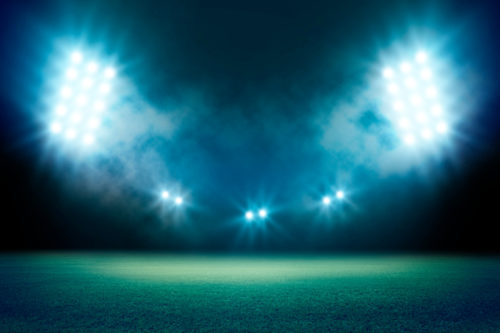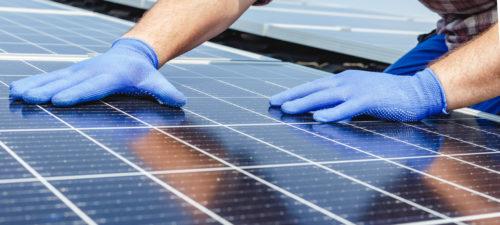How to Manufacture High-Quality LED Lighting
Leave a CommentLight-emitting diodes (LEDs) produce light through a semiconductor. Semiconductors create visible light when a current causes electrons to transfer between one atom to an atom missing an electron. Light photons illuminate the LED as energy is released. The lights illuminate everything from automobile dashboards to athletic stadiums and can carry short-range optical signals for remote controls and telecommunications. We will discuss the LED fabrication process, the benefits of LED lighting,and choosing an LED glass panel to make your LED installation project a success.
LED Lighting & Its Benefits
LED lighting reduces energy consumption by up to 90% compared to standard bulbs, and reaches an average lifespan of 50,000 hours, or 40 times longer than standard bulbs. The diode of the LED is encased in an epoxy resin, providing improved durability over the filaments of incandescent lights. LEDs can resist vibrations, impacts, and shocks. They are also ideal lighting solutions in extremely high or low temperatures.

LED lights provide the following benefits:
- Low-voltage operation
- Instant illumination
- Design versatility
- UV and heat-free illumination
- Perform in harsh conditions
What Materials Go Into an LED?
Diodes in LED lighting consist of semiconductor layers measuring 0.5 microns or less. Each layer alternates between an excess and a deficit of electrons, allowing the electrons to pass between the layers to create light energy.
Manufacturers can manipulate the electron density through impurities called dopants in the semiconductor. Impurities in higher densities allow the crystalline structure within the semiconductor to conduct electricity. LED manufacturers prefer gallium arsenide phosphide (GaAsP), gallium phosphide (GaP), and gallium arsenide (GaAs) semiconductors to create distinct LED light colors. The impurities are intentionally added during the doping process to enhance the lighting.
Impurities or dopants include:
- Tellurium
- Germanium
- Silicon
- Nitrogen
- Zinc
Manufacturers attach wires to the semiconductor using a silver or gold compound to chemically bond the conductor to the surface and allow an electrical current to run through it. An epoxy resin encasing the LED allows manufacturers to change the optical properties and appearance of the LED. They can scatter, pinpoint, or shape the light and tint the plastic for more color variation.
How is LED Lighting Made?
LED lighting is made in the following four steps:
- Making Semiconductor Wafers: Phosphor, arsenic, and/or gallium are combined in a pressure- and temperature-controlled chamber. The liquefied materials are deposited on a rod to create an ingot. Wafers are sliced from the ingot, smoothed, and dipped in a solution to remove contaminants.
- Adding Additional Layers: Micron thick layers of crystal and dopants are added to the wafer using the liquid phase epitaxy (LPE) process, where crystal layers are grown by depositing molten GaAsp mixed with dopants on the wafer. Dopants can also be added in a high-temperature furnace containing gaseous dopants.
- Adding Metal Contacts: A photoresist compound is deposited on the wafer as it spins to create a predetermined pattern on its surface. The compound hardens at temperatures of around 215 °F and the wafer is exposed to UV light, creating a duplicate pattern on the photoresist. The exposed areas are filled by evaporating contact metal on the wafer in a high-temperature vacuum-sealed chamber. The LED is placed in a furnace with an inert hydrogen or nitrogen atmosphere and heated to bond the metal to the wafer surface. The wafers are snapped on a crystal plane or sawed with a diamond-tipped saw to create up to 6000 dies.
- Mounting: The dies are mounted to a package, and the back of the die receives a metal coating to form an electrical contact. The assembly is sealed in molded epoxy to form the desired shape.
Choosing the Right Glass for LED Lighting
Facilities like indoor farms, stadiums, warehouses, and commercial buildings demand glass panels for LED lighting parts. At Swift Glass, we have manufactured glass panels for the leading LED installers, offering thermal tempering for high-strength glass and specialty glass. Swift Glass is the oldest US-based tempered glass supplier. We offer various machining services and materials to deliver ideal LED glass solutions, including:
- A range of options, including patterned, float, and Borosilicate glass
- High-volume CNC cutting capabilities
- Edge polishing
- Chemical strengthening
- Hole drilling
Swift Glass: Your Partner for LED Lighting and Glass Solutions
Swift Glass is a national leader in manufacturing lighting glass and LED glass panels. We have more than 80 years of experience in the industry and are trusted by the nation’s largest LED installers. Rely on our various capabilities, including thermal tempering to increase glass strength, specialty glass, and machining services. Swift Glass is your superior partner for commercial LED lighting and glass solutions. Visit our lighting applications page or contact us to learn more about our LED lighting systems and request a quote today to partner with Swift Glass.
Glass for Solar Applications
Leave a CommentWhen choosing a solar panel, people often consider elements such as the solar PV panel’s power and overall efficiency. However, they may not consider how the type of solar panel glass influences performance. The glass also plays a key role in protecting the panel’s photovoltaic cells against environmental factors.
It’s important not to overlook solar panel glass when looking for the ideal solar panel model. Here we’ll go over what options to look for and what they can do for your solar panels.
The Function of Solar Panel Glass
Solar panel glass performs a few main functions for solar panels, including:
- Protection from damage — Tempered solar panel glass serves as a protective layer for solar panels, preventing environmental factors like vapors, water, and dirt from damaging the photovoltaic cells. Tempered solar panel glass also provides high strength, excellent transmissivity, and low reflection.
- Durability and safety — Tempered glass offers up to four times more strength than standard glass. This strength is critical as the solar panel’s front sheet requires lasting protection against the elements. Thanks to the thermal and chemical processes that produce tempered glass, it is also known as toughened or safety glass. Tempered glass is safer to use because it shatters into many smaller pieces when broken, reducing the probability of accidental injury.
- Weight — Glass must be of a certain weight for solar panels. The industry standard weight for a 3.2 mm thick solar panel glass is around 20 kg. Tempered glass can provide this minimum weight, avoiding the dangers of cheap, lightweight solar panel glass.
Types of Solar Panel Glass
Solar panel glass may consist of two main types: thin-film or crystalline. Both have distinct features to keep in mind.
- Thin-Film — Thin-film glass is lightweight, cost-effective, and easy to install. They are made of standard, non-tempered glass and can be as thin as 2.5 mm. Thin-film solar panels are lightweight because the glass encloses the panel without a frame. They require the most space and have the lowest efficiency out of all the solar panel glass options.
- Crystalline — Solar panels made with crystalline glass tend to have a thickness of 3 to 4 mm, which adds more stability. This glass has a unique rough surface, which enables the glass to bond well with the panel’s EVA film for lamination purposes. Smooth glass can lead to gradual delamination. There are two subtypes of crystalline glass: monocrystalline and polycrystalline. Both of these crystalline panels require a fabrication method that involves producing silicon crystals that are cut into thinner wafers for use in solar panel glass.
- Monocrystalline — These panels feature a sleek look and optimal efficiency, but they’re slightly more expensive than polycrystalline glass.
- Polycrystalline — These are less expensive than their monocrystalline counterparts, at the cost of reduced visual appeal and efficiency.
While some applications may call for cheaper glass panels, delamination and inadequate protection could reduce the longevity of your solar panels. Instead, opt for tempered glass with IEC61215, IEC61730, and UL1307 certification, which indicate that the panel has held up in safety and quality tests.
Solar Panels from Swift Glass
Swift Glass provides the best products available if you require high-quality solar panel glass for your solar assembly. Our selection includes Optiwhite and Starphire glass, both of which are low-iron glasses for solar applications.
Your Partner for Quality Solar Panel Glass
At Swift Glass, we offer reliable solar panel glass materials, with manufacturing capabilities including bending, CNC machining, thermal tempering, waterjet cutting, and more depending on customer needs. We have worked with top glass manufacturers, including GE, Corning, Auer, and Schott. Our company is ITAR registered and ISO 9001:2015 certified, and we pride ourselves on being a global leader in fabricating quality glass components.
To find out more about our solar panel glass fabrication capabilities, contact us or request a quote today.



